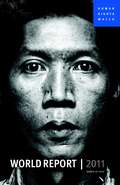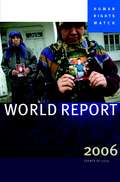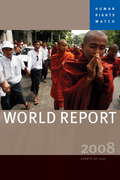Special Collections
Human Rights Collection
- Table View
- List View
Testing Justice
by Human Rights WatchThe 68-page report reveals that the backlog of untested rape kits in Los Angeles County is larger and more widespread than previously reported. Through dozens of interviews with police officers, public officials, criminalists, rape treatment providers, and rape victims, the report documents the devastating effects of the backlog on victims of sexual abuse.
So Long as They Die
by Human Rights WatchThis 65-page report reveals the slipshod history of executions by lethal injection, using a protocol created three decades ago with no scientific research, nor modern adaptation, and still unchanged today. As the prisoner lies strapped to a gurney, a series of three drugs is injected into his vein by executioners hidden behind a wall. A massive dose of sodium thiopental, an anesthetic, is injected first, followed by pancuronium bromide, which paralyzes voluntary muscles, but leaves the prisoner fully conscious and able to experience pain. A third drug, potassium chloride, quickly causes cardiac arrest, but the drug is so painful that veterinarian guidelines prohibit its use unless a veterinarian first ensures that the pet to be put down is deeply unconscious. No such precaution is taken for prisoners being executed.
Cruel and Degrading
by Human Rights WatchThis 20-page report publicly reveals this practice for the first time. It also shows that the practice is not only cruel, but wholly unnecessary as there are safer, more humane alternatives that corrections officers can use – and most across the country do use – to remove prisoners from their cells.
Forced Apart
by Human Rights WatchThe 64-page report uses data from 1997 to 2007 from US Immigration and Customs Enforcement (ICE), to evaluate the effects of sweeping deportation laws passed in 1996. It shows that some of the most common crimes for which people were deported were relatively minor offenses, such as marijuana and cocaine possession or traffic offenses. Among legal immigrants who were deported, 77 percent had been convicted for such nonviolent crimes. Many had lived in the country for years and were forced apart from close family members.
Submission to the Committee on the Elimination of Racial Discrimination
by Human Rights Watchthis 48-page report, Human Rights Watch documents US noncompliance with ICERD in seven key areas. The treaty, ratified by the United States in 1994, requires member governments to take affirmative steps to eliminate discrimination on the basis of race, color, or national or ethnic origin in all areas of public life. The Human Rights Watch report was prepared for submission to the Committee on the Elimination of Racial Discrimination, an international body that monitors and reports on compliance with ICERD. The committee will examine US compliance with ICERD at a session in Geneva, Switzerland, on February 21-22, 2008.
Decades of Disparity
by Human Rights WatchThis 20-page report says that adult African Americans were arrested on drug charges at rates that were 2.8 to 5.5 times as high as those of white adults in every year from 1980 through 2007, the last year for which complete data were available. About one in three of the more than 25.4 million adult drug arrestees during that period was African American.
Forced Apart
by Human Rights WatchThis 88-page report is the first comprehensive assessment of the deportation of non-citizens with criminal convictions and the impact on families and communities in the US. The mandatory deportation of legal immigrants convicted of a crime, even a minor one, has separated an estimated 1.6 million children and adults, including US citizens and lawful permanent residents, from their non-citizen family members. Many of those deported arrived in the US as children and were lawful permanent residents who had lived legally in the country for decades.
Ill-Equipped
by Human Rights Watch StaffMentally ill offenders face mistreatment and neglect in many U.S. prisons. One in six U.S. prisoners is mentally ill. Many of them suffer from serious illnesses such as schizophrenia, bipolar disorder, and major depression. There are three times as many men and women with mental illness in U.S. prisons as in mental health hospitals. The rate of mental illness in the prison population is three times higher than in the general population. This 215-page report examines how prisons are dangerous and damaging places for mentally ill people. Other prisoners victimize and exploit them. Prison staff often punish mentally ill offenders for symptoms of their illness - such as being noisy or refusing orders, or even self-mutilation and attempted suicide. Mentally ill prisoners are more likely than others to end up housed in especially harsh conditions, such as isolation, that can push them over the edge into acute psychosis. Woefully deficient mental health services in many prisons leave prisoners undertreated - or not treated at all. Across the country, prisoners cannot get appropriate care because of a shortage of qualified staff, lack of facilities, and prison rules that interfere with treatment. The report is based on more than two years of research and hundreds of interviews with prisoners, corrections officials, mental health experts and attorneys and makes recommendations on services and regulations that would assist and protect mentally ill prisoners.
Custody and Control
by Human Rights WatchThis 136-page report provides an in-depth look at the abuses and neglect suffered by girls confined in two remote New York State juvenile facilities known as Tryon and Lansing. The facilities are operated by the New York Office of Children and Family Services (OCFS) and are the only two higher-security facilities in New York State holding girls.
A Violent Education
by Human Rights WatchIn this 125-page report, the ACLU and Human Rights Watch found that in Texas and Mississippi children ranging in age from 3 to 19 years old are routinely physically punished for minor infractions such as chewing gum, talking back to a teacher, or violating the dress code, as well as for more serious transgressions such as fighting. Corporal punishment, legal in 21 states, typically takes the form of “paddling,” during which an administrator or teacher hits a child repeatedly on the buttocks with a long wooden board. The report shows that, as a result of paddling, many children are left injured, degraded, and disengaged from school.
“We are Not the Enemy”
by Human Rights WatchPublic officials tried vigorously to contain a wave of hate crimes in the United States after September 11, Human Rights Watch said in a report released today. Nevertheless, anti-Muslim hate crimes in the United States rose 1700 percent during 2001. The report documents anti-Arab and anti-Muslim violence and the local, state and federal response to it. The forty-one page report, “We Are Not the Enemy,” draws on research with police, prosecutors, community activists, and victims of hate crimes in six cities (Seattle, Washington; Dearborn, Michigan; Chicago, Illinois; Los Angeles, California; Phoenix, Arizona; and New York, New York) to review steps taken by government officials to prevent and prosecute hate crimes after the September 11 attacks in New York and Washington, D.C. The report also examines the scope and extent of these hate crimes, which included murder, assault, arson, and vandalism. “Government officials didn’t sit on their hands while Muslims and Arabs were attacked after September 11,” said Amardeep Singh, author of the report and U.S. Program researcher at Human Rights Watch. “But law enforcement and other government agencies should have been better prepared for this kind of onslaught.”
World Report 2011
by Human Rights WatchHuman Rights Watch is increasingly recognized as the world's leader in building a stronger awareness for human rights. Their annual World Report is the most probing review of human rights developments available anywhere. Written in straightforward, non-technical language, Human Rights Watch World Report prioritizes events in the most affected countries during the previous year. The backbone of the report consists of a series of concise overviews of the most pressing human rights issues in countries from Afghanistan to Zimbabwe, with particular focus on the role--positive or negative--played in each country by key domestic and international figures. Highly anticipated and widely publicized by the U.S. and international press every year, the World Report is an invaluable resource for journalists, diplomats, and all citizens of the world.
World Report 2007
by Human Rights WatchHuman Rights Watch is increasingly recognized as the world's leader in building a stronger awareness for human rights. Their annual World Report is the most probing review of human rights developments available anywhere. Written in straightforward, non-technical language, Human Rights Watch World Report prioritizes events in the most affected countries during the previous year. The backbone of the report consists of a series of concise overviews of the most pressing human rights issues in countries from Afghanistan to Zimbabwe, with particular focus on the role--positive or negative--played in each country by key domestic and international figures. Highly anticipated and widely publicized by the U.S. and international press every year, the World Report is an invaluable resource for journalists, diplomats, and all citizens of the world.
World Report 2006
by Human Rights WatchHuman Rights Watch is increasingly recognized as the world's leader in building a stronger awareness for human rights. Their annual World Report is the most probing review of human rights developments available anywhere. Written in straightforward, non-technical language, Human Rights Watch World Report prioritizes events in the most affected countries during the previous year. The backbone of the report consists of a series of concise overviews of the most pressing human rights issues in countries from Afghanistan to Zimbabwe, with particular focus on the role--positive or negative--played in each country by key domestic and international figures. Highly anticipated and widely publicized by the U.S. and international press every year, the World Report is an invaluable resource for journalists, diplomats, and all citizens of the world.
“Please, do not make us suffer any more…”
by Human Rights WatchIn this 47-page report Human Rights Watch said that countries could significantly improve access to pain medications by addressing the causes of their poor availability. These often include the failure to put in place functioning supply and distribution systems; absence of government policies to ensure their availability; insufficient instruction for healthcare workers; excessively strict drug-control regulations; and fear of legal sanctions among healthcare workers.
Unprotected
by Human Rights WatchIn this 70-page report, Human Rights Watch says that the Philippine government bans the use of national funds for condom supplies. Some local authorities, such as the mayor of Manila City, prohibit the distribution of condoms in government health facilities. School-based HIV/AIDS educators told Human Rights Watch that schools often prohibited them from discussing condoms with students.
In the Shadow of Death
by Human Rights WatchHuman immuno-deficiency virus/acquired immune deficiency syndrome (HIV/AIDS) is a national disaster for the people of Kenya, children and adults alike. Kenya is estimated to have the ninth-highest prevalence of HIV in the world with about 14 percent of the adult population infected. An estimated 1 million orphans in the country represent only a fraction of the population of children affected by AIDS, which includes children withdrawn from school to care for a sick relative, those in families caring for orphans, and those who have had to become breadwinners to replace the income of a sick parent. Kenya is far from alone in needing to strengthen protections of the rights of AIDS-affected children. Governments around the world have neglected the consequences of AIDS on children and have failed to provide the necessary protections of their rights to survival and development. This failure is one of the most pervasive and lasting crises of the HIV/AIDS catastrophe, and it must be addressed with the greatest urgency.
A Dose of Reality
by Human Rights WatchGovernments around the world have done far too little to combat the entrenched, chronic abuses of women's and girls' human rights that put them at risk of HIV. Misguided HIV/AIDS programs and policies, such as those emphasizing abstinence until marriage, ignore the brutal realities many women and girls face. By failing to enact and effectively enforce laws on domestic violence, marital rape, women's equal property rights, and sexual abuse of girls, and by tolerating customs and traditions that subordinate women, governments are enabling HIV/AIDS to continue claiming the lives of women and girls. Human Rights Watch has interviewed hundreds of women and girls living with HIV around the world. This briefing paper focuses on the links between HIV/AIDS and abuses of women's and girls' human rights.
Blood, Sweat, and Fear
by Human Rights WatchWorkers in the U.S. meat and poultry industry endure unnecessarily hazardous work conditions, and the companies employing them often use illegal tactics to crush union organizing efforts. In meat and poultry plants across the United States, Human Rights Watch found that many workers face a real danger of losing a limb, or even their lives, in unsafe work conditions.
No Bright Future
by Human Rights WatchThis 72-page report documents how the abusive policies and practices of the Zimbabwean government are fueling the HIV/AIDS epidemic, increasing vulnerability to infection, and obstructing access to treatment.
Policy Paralysis
by Human Rights WatchThis 90-page report documents human rights abuses that women and girls suffer at each stage of their lives and that increase their risk for HIV infection. Girls face sexual abuse and violence, in and out of school. Women in long-term relationships risk violence if they insist on condom use or refuse sex. Widows are discriminated against in property and inheritance rights. And women and girls are raped in war and civil conflict, where rape is used strategically as a weapon.
Witness to Abuse
by Human Rights WatchThe 101-page report, documents how the Justice Department denied the witnesses fundamental due process safeguards. Many were not informed of the reason for their arrest, allowed immediate access to a lawyer, nor permitted to see the evidence used against them. The Justice Department evaded fundamental protections for the suspects and the legal requirements for arrested witnesses. Their court proceedings were conducted behind closed doors, and all the court documents were sealed.
Suffering in Silence
by Human Rights WatchSexual abuse of girls in Zambia fuels the HIV/AIDS epidemic and the strikingly higher HIV prevalence among girls than boys, Human Rights Watch said today. Concerted national and international efforts to protect the rights of girls and young women are key to curbing the AIDS epidemic's destructive course.
Injecting Reason
by Human Rights WatchGovernment interference with sterile syringe programs is thwarting HIV prevention efforts in California. State laws and local enforcement are preventing drug users from obtaining the sterile syringes they need to protect themselves from HIV. This 61-page report documents police stopping, arresting, and harassing participants in needle exchange programs established by some California counties under state law. Even where needle exchange programs are legal, police remain authorized to arrest program participants under an antiquated law prohibiting the possession of "drug paraphernalia." Over a quarter of new AIDS cases in the United States can be traced to infected syringes. Sharing syringes is also a major risk factor in the spread of hepatitis B and C. California is home to nearly one eighth of reported AIDS cases in the United States. The Human Rights Watch report recommends legalization of needle exchange programs and nonprescription pharmacy sales of syringes. It also calls on police departments to cease stops and seizures of participants in clean needle programs, a practice courts have recently prohibited in Connecticut, Massachusetts and New York.
Ignorance Only
by Human Rights WatchPrograms teaching teenagers to "just say no" to sex before marriage are threatening adolescent health by censoring basic information about how to prevent HIV/AIDS, Human Rights Watch charged in a new report released today. The forty-seven page report focuses on federally funded "abstinence-only-until-marriage" programs in Texas, where advertising campaigns convey the message that teenagers should not use condoms because they don't work. Some school-based programs in Texas do not mention condoms at all. Federal health agencies share the broad scientific consensus that condoms, when used correctly, are highly effective in preventing the transmission of HIV. Yet the U.S. government currently spends more than $ 100 million each year on "abstinence-only-until-marriage" programs, which cannot by law "promote or endorse" condoms or provide instruction regarding their use. The Bush administration is advocating a 33 percent increase in funding for these programs.



